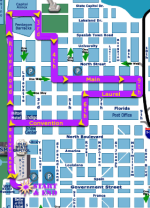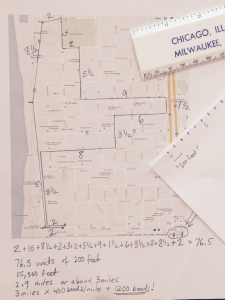Intended Audience: Grades 4 – 8 math teachers and/or home school parents, or anybody who is interested in Mardi Gras parades!
We enjoy going to family-friendly Mardi Gras parades in Louisiana. These parades are exciting events filled with floats where riders throw beads and stuffed animals to children. At the 2015 “Krewe of Artemis” parade in Baton Rouge, Autumn and I wondered:
How many beads does a float rider need to buy for a Mardi Gras parade?
That question lead to “The Mardi Gras Problem” video. The video can be used as part of an enrichment activity that investigates the following topics in mathematics: measurement, scale drawings, ratios and proportional relationships, estimation, and length conversions.
The steps for doing this activity are:
STEP 1. Show the video. It gives a 3 minute introduction of a family-friendly Mardi Gras parade “Krewe of Artemis” and sets up the problem.
STEP 2. Hand out the picture of the 2015 parade route and one of the two Google maps below. About half of the students should get the first map Google map and half of the students get the second map.

![]()
![]()
STEP 3. Let the kids think about a plan of attack on their own. Talk to individuals or small groups and offer hints for starting the problem. If necessary, after 3-4 minutes, suggest to the whole group that they might start by redrawing the route on the Google map. Ask: What information does the Google map provide that the parade route map doesn’t? How can you use that information?
STEP 4. Offer students rulers or better yet, suggest they use the edge of a cardboard stock to create a ruler such that the distance between adjacent marks is the length of the “200 feet” segment at the bottom of the Google map (see “answer” picture below). Let students work for the next 10-20 minutes estimating parade route length by measuring the number of “200 feet” lengths using their ruler (Answer: about 76.5 units of “200 feet” lengths.)
STEP 5. Guide students to calculate the length of the parade in feet: If 1 unit is 200 feet, then 76.5 units is 15,300 feet. Use either tape/arrow diagrams or rate calculations (depending on your grade) to explain how to do this.
STEP 6. Remember to ask why students who used Map 1 got the same number of feet as students who used Map 2. Have a delightful discussion of proportional relationships and scale drawings!
STEP 7. Using the conversion, 5280 feet = 1 mile, convert the number of feet to miles to get approximately 2.9 miles. Conclude that 3 miles is a good estimate for the length of the parade.
STEP 8. Recall that Autumn said that bead throwers should expect to throw about 400 beads per mile. Therefore, a bead thrower should buy approximately 1200 beads for the Artemis parade.
Here’s a picture of the measurements and numbers reached along the way. Your students’ work will not look exactly like this, but all should reasonably conclude that 3 miles is a fair estimate of the length of the parade.
The Mardi Gras Problem is obviously more robust and longer than anything that could be reasonably put on a PARCC or Smarter Balanced assessment. However, it wouldn’t surprise me in the least if there were questions on those assessments that were similar to parts of this problem.
CHANNEL: Growing up with Eureka
© 2015 Autumn Baldridge and Scott Baldridge
Supported by NSF CAREER grant DMS-0748636










Awesome…will use with students …Go Autumn!
LikeLiked by 1 person